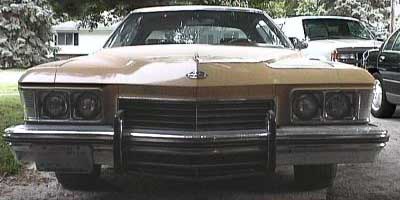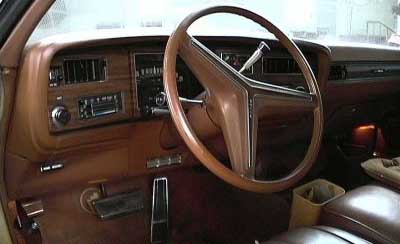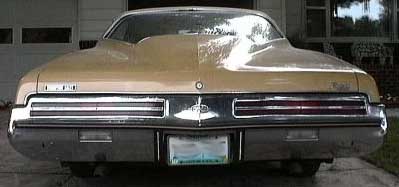|
Evolution
of the Riviera - 1973
by Sean Cahill #6613
Originally published in The Riview Vol. 19, No. 6 Sept./Otc.
2003

New Front End treatment for the '73
|
1973 was the third and last year for the controversial boattail
design, with the most changes done on this year. A major facelift
of both front and rear bumper designs, as well as other interior
and exterior items came about. A softer, more luxurious approach
to the car was taken by Buick.
The obvious differences in the exterior of the car can be seen
in the front bumper, now a government-mandated impact resistant
unit, and in the more conventional rear bumper, now with the license
plate in the center, and much flatter than the '71 and '72 rear
bumpers. The stylized Riviera emblem now appeared above the grille,
and on the rear bumper, as well as on the sail panels. Front parking
lamps and turn signals were moved to the outer edge of the fenders,
combining the side marker lamps and optional cornering lamps. If the car was equipped
with the optional Stage 1 engine, the Stage I emblem was placed
in the grille for the first time. These additions and changes brought
another 143 pounds to the weight of the car.
|
Interior changes again took the Riviera closer to the luxury side
of the market. The high back bucket seats that were available in
'71 and '72 were now replaced with 40-40 seats. Also available was
a 60-40 seat. The unique three panel machine-turned trimmed cockpit
was replaced by a wood grain trimmed instrument panel similar to
other full-size Buicks, and was no longer curved on the passenger
side. Other improvements included an increase in sounddeadening
materials, more supple body mounts, and improvements to the suspension,
again, to make the '73 quieter and smoother.
|
 Woodgrain dash replaced the engine turned aluminum finish of the
'71-'72 Boattail
Woodgrain dash replaced the engine turned aluminum finish of the
'71-'72 Boattail |
| The same 250 horse power engine used in '72 was standard,
along with a 2.93:1 rear axle ratio. The GS option was still available
for '73. The Stage I engine was a $139 option, and was not included
in the GS package. Suspension was upgraded with different springs and
shocks, the addition of a rear sway bar, a 3.23:1 posi-traction differential,
radial tires, and a recalibrated turbo 400 transmission. This was the
third and last year for the Max-Trac option. This was a "computer"
controlled device that prevented wheelspin by limiting engine acceleration.
Though it was not available in '74, this option was the predecessor
to the units now seen on many modem performance cars. |
| 
New Bumper put the license plate in the center and eliminated
the point of the tail
|
This was the last year for the true pillarless
hardtop design. Also, exhaust gas recirculation was now standard on
the Riviera, having been installed only on California cars before.
Paint options included 16 standard colors, as well as Black, Mediterranean
Blue and Jade Green as extra cost options. There were seven interior
and vinyl top colors available. The interior vinyl had two different
types of grain, again to give the car the more luxurious look of real
leather.
|
The most common options for '73 included air conditioning,
with 99.3% of the cars equipped. Power windows were added to 97.2% of
the cars, 87.5% had the power seat, and 81.1% had a vinyl top. Cruise
control was installed on 53.8% of all cars. Other options included both
a manual and a power sun roof, AM FM 8-track radios, front fender light
monitors, power trunk release, and chrome road wheels.
|
| Year |
Body |
Total Production |
|
|
Engine Size |
HP |
Carbs |
Produced |
1973 |
4EY87 |
34,080 (Includes 3,933 GS Handling Option) |
Standard: |
|
455 cu. in. V8 |
250 |
1x4bbl |
34,080 |
| 1,234 Stage 1 Option |
Stage 1 Option: |
Dual Exhaust |
260 |
1234 |
| Year
|
Curb Weight |
Wheelbase
|
Track |
Length
|
Width
|
Height
|
Tire |
| Front |
Rear |
Size |
1973 |
|
122 |
63.6 |
64 |
223.4 |
79.9 |
54 |
|
|



